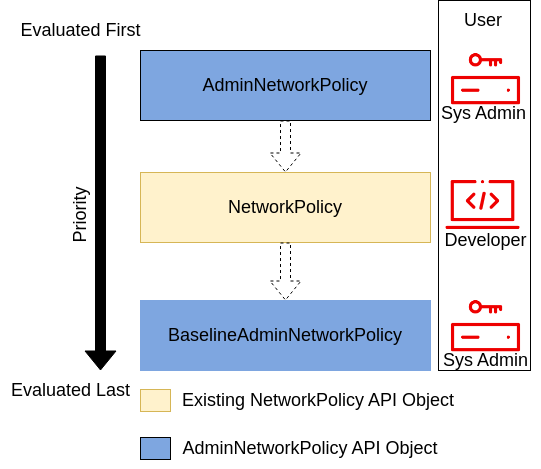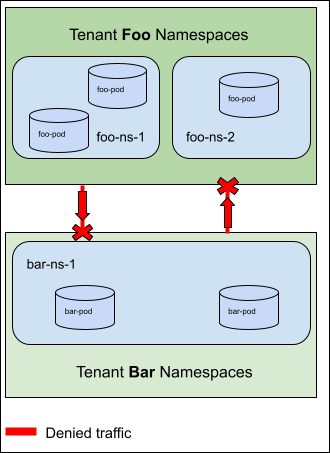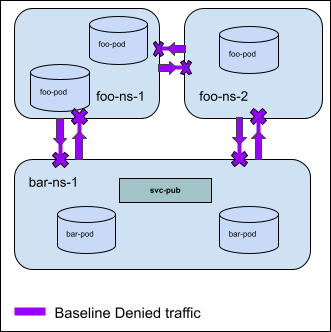Introduction
What is the AdminNetworkPolicy API?¶
The AdminNetworkPolicy API is an open source project managed by the SIG-NETWORK community. It is a collection of resources, which aim to make securing Kubernetes clusters easier for Administrators.

Getting started¶
Whether you are a user interested in using the AdminNetworkPolicy API or an implementer interested in conforming to the API, the following resources will help give you the necessary background:
AdminNetworkPolicy API User Stories¶
The following user stories drive the concepts of the AdminNetworkPolicy API for the
v1alpha1 version of the api. More information on how the community ended up here
can be found in the API KEP
and in the accompanying KEP PR
Future API developments should all start with a well-defined and intentional user story.
Story 1: Deny traffic at a cluster level¶
As a cluster admin, I want to apply non-overridable deny rules to certain pod(s) and(or) Namespace(s) that isolate the selected resources from all other cluster internal traffic.
For Example: In this diagram there is a AdminNetworkPolicy applied to the
sensitive-ns denying ingress from all other in-cluster resources for all
ports and protocols.

Story 2: Allow traffic at a cluster level¶
As a cluster admin, I want to apply non-overridable allow rules to
certain pods(s) and(or) Namespace(s) that enable the selected resources
to communicate with all other cluster internal entities.
For Example: In this diagram there is a AdminNetworkPolicy applied to every
namespace in the cluster allowing egress traffic to kube-dns pods, and ingress
traffic from pods in monitoring-ns for all ports and protocols.

Story 3: Explicitly Delegate traffic to existing K8s Network Policy¶
As a cluster admin, I want to explicitly delegate traffic so that it skips any remaining cluster network policies and is handled by standard namespace scoped network policies.
For Example: In the diagram below egress traffic destined for the service svc-pub in namespace bar-ns-1 on TCP port 8080 is delegated to the k8s network policies implemented in foo-ns-1 and foo-ns-2. If no k8s network policies touch the delegated traffic the traffic will be allowed.

Story 4: Create and Isolate multiple tenants in a cluster¶
As a cluster admin, I want to build tenants in my cluster that are isolated from each other by default. Tenancy may be modeled as 1:1, where 1 tenant is mapped to a single Namespace, or 1:n, where a single tenant may own more than 1 Namespace.
For Example: In the diagram below two tenants (Foo and Bar) are defined such that all ingress traffic is denied to either tenant.

Story 5: Cluster Wide Default Guardrails¶
As a cluster admin I want to change the default security model for my cluster, so that all intra-cluster traffic (except for certain essential traffic) is blocked by default. Namespace owners will need to use NetworkPolicies to explicitly allow known traffic. This follows a whitelist model which is familiar to many security administrators, and similar to how kubernetes suggests network policy be used.
For Example: In the following diagram all Ingress traffic to every cluster resource is denied by a baseline deny rule.

Who is working on AdminNetworkPolicy?¶
The AdminNetworkPolicy API is a SIG-Network project being built to improve and standardize cluster-wide security policy in k8s. In-progress implementations include Antrea (VMware) and Openshift (RedHat), If you are interested in contributing to or building an implementation using the AdminNetworkPolicy API then don’t hesitate to get involved!